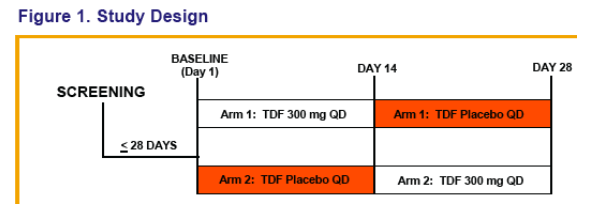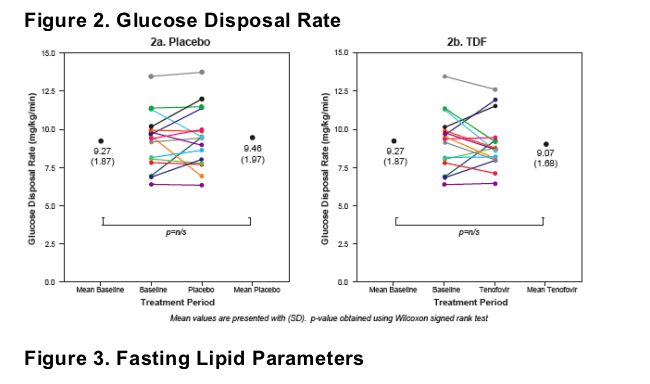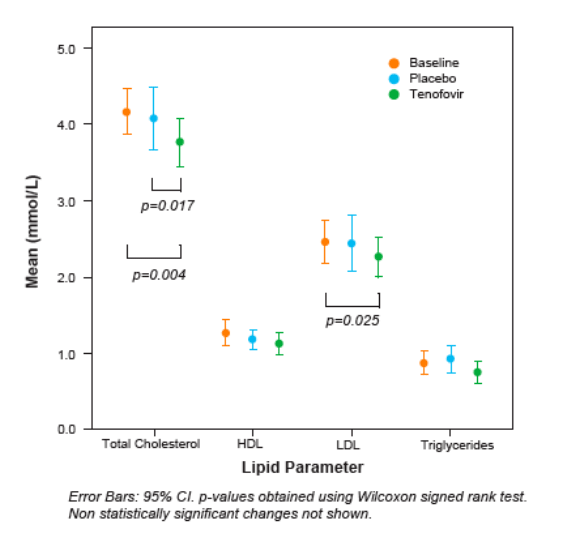 |
 |
 |
| |
The Impact of Tenofovir on Insulin Sensitivity and Lipids in Healthy Volunteers
|
| |
| |
Reported by Jules Levin
ICAAC/IDSA Oct 27 2008 Wash DC
P Randell,1 A Jackson,1 L Zhong,2 K Yale,2 and G Moyle1
1Chelsea and Westminster Hosp., London, UK; 2Gilead Sciences, Inc, Foster City, CA, USA
AUTHOR CONCLUSIONS
Two-week dosing with TDF did not have a significant impact on insulin sensitivity
Statistically significant reductions in total cholesterol and LDL cholesterol were seen after 2 weeks of TDF
These study results are consistent with previous observations that no significant mitochondrial toxicity was associated with TDF8
INTRODUCTION
Effective antiretroviral therapy has resulted in a dramatic improvement in HIV associated morbidity and mortality
Certain antiretrovirals are associated with metabolic side effects including dyslipidaemia, body fat changes and insulin resistance1
These effects are variable not only between different drug classes but between drugs in the same class
BACKGROUND
The hyperinsulinaemic euglycaemic clamp2 is considered the gold standard for investigating insulin sensitivity and a number of trials have used the clamp methodology to investigate antiretrovirals
The development of insulin resistance in healthy volunteers has been seen with lopinavir/ritonavir3, ritonavir4, indinavir5 and stavudine6 but not with amprenavir4 or atazanavir3
Insulin resistance associated with protease inhibitors appears to be mediated through the inhibition of the glucose transporter GLUT47
Mitochondrial toxicity is implicated in the development of insulin resistance with nucleoside reverse transcriptase inhibitors6
OBJECTIVES
To investigate the impact of tenofovir disoproxil fumarate (TDF) on insulin sensitivity as assessed by the peripheral glucose disposal rate during the last hour of the hyperinsulinaemic euglycaemic clamp
To investigate the impact of TDF on lipid parameters
METHODS
Single centre, randomised, double blinded, placebo-controlled study that utilised a 2 sequence, 2 period crossover design
HIV negative subjects were recruited and randomised 1:1 as shown (fig 1)

Important exclusion criteria were BMI >28kg/m2, waist:hip ratio >0.97 and any medication or disease process likely to cause a marked disturbance in glucose and lipid homeostasis. Fasting glucose, cholesterol and triglycerides also had to be within normal limits
A hyperinsulinaemic euglycaemic clamp and fasting bloods were performed at baseline, after 2 weeks of treatment and after 4 weeks of treatment (2 weeks after treatment switch)
Peripheral glucose disposal rate was assessed during the last hour (120-180 min) of the clamp
RESULTS
19 subjects were randomised. 16 male subjects completed all 3 clamp procedures (3 withdrew prior to baseline visit)
Subjects had mean age of 27.4 years and mean BMI of 23.02 kg/m2
7 subjects received TDF followed by placebo and 9 received placebo followed by TDF
No significant change from baseline in the mean peripheral glucose disposal rate was seen after 2 weeks of TDF (fig 2b) or placebo (fig 2a)
- No significant difference between placebo and TDF
Statistically significant decreases from baseline in total cholesterol and LDL cholesterol were seen after 2 weeks of TDF (fig 3)


REFERENCES
1. Grinspoon S, Carr A. Cardiovascular risk and body-fat abnormalities in HIV-infected adults. N Engl J Med 2005;352:48-62.
2. DeFronzo RA, Tobin JD, Andres R. Glucose clamp technique: a method for quantifying insulin secretion and resistance. Am J Physiol. 1979;237(3):E214-E23.
3. Noor MA, Parker RA, O'Mara E, et al. The effects of HIV protease inhibitors atazanavir and lopinavir/ritonavir on insulin sensitivity in HIV-seronegative healthy adults. AIDS. 2004;18(16):2137-44.
4. Lee GA, Rao M, Mulligan K, et al. Effects of ritonavir and amprenavir on insulin sensitivity in healthy volunteers. AIDS. 2007;21(16):2183-90.
5. Noor MA, Seneviratne T, Aweeka FT, et al. Indinavir acutely inhibits insulin-stimulated glucose disposal in humans: A randomized, placebo-controlled study. AIDS. 2002;16(5):F1-F8.
6. Fleischman A, Johnsen S, Systrom DM, et al. Effects of a nucleoside reverse transcriptase inhibitor, stavudine, on glucose disposal and mitochondrial function in muscle of healthy adults. Am J Physiol Endocrinol Metab. 2007;292:E1666-E73.
7. Murata H, Hruz PW, Mueckler M. The mechanism of insulin resistance
caused by HIV protease inhibitor therapy. The Journal of Biological Chemistry.
2000;275(27):20251-4.
8. Birkus B, Hitchcock M, Cihlar T. Assessment of mitochondrial toxicity in human cells treated with tenofovir: comparison with other nucleoside reverse transcriptase Inhibitors. Antimicrobial Agents and Chemotherapy. 2002;46(3):716-723.
|
| |
|
 |
 |
|
|